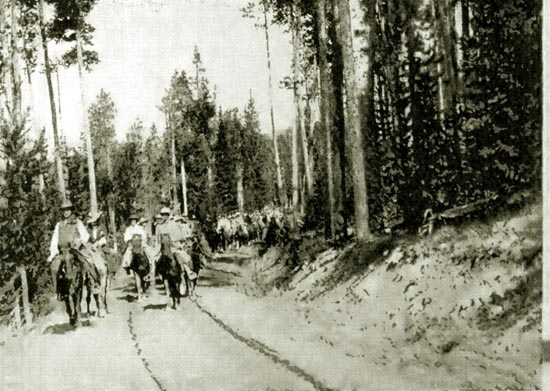
Howard Eaton leading a tour of Yellowstone, 1915.
As previously noted, beginning in 1898, two-week tours of Yellowstone Park under the guidance of Howard Eaton were annual events. Additonally,
longer tours to the Grand Canyon were made. The Eaton Brothers ranch was well publicized in eastern magazines. President
Roosevelt had added publicity to the ranch and Howard Eaton. If Howard Eaton was a recognized outstanding guide, he was an
absolute genus at garnering publicity for the ranch all seemingly without deliberate effort.
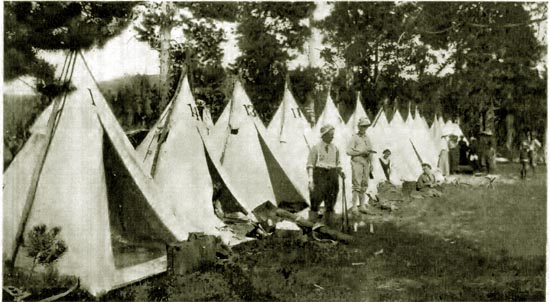
Eaton Camp Yellowstone National Park, approx. 1915
In 1915, Howard Eaton scored a master stroke. In 1915,
Glacier National Park had opened. That year, Howard Eaton stopped off in Pittsburgh on one of his trips to the
east. In Pittsburgh, Eaton proposed to Mary Roberts Rinehart that she join him in a proposed trip two-week trip through the eastern side of the
Park. The western side of the Park had not yet opened. At the time, Rinehart was one of America's most popular writers. In addition to mystery
novels her prolific pen produced numerous stories for some of the country's most popular periodicals including
The Saturday Evening Post and Collier's. At first, Rinehart was reluctant. She was somewhat in a state of
depression from her recent trip to Belgium and the loss of a friend on the R.M.S. Lusitania. The trip provided an impetus for
a new book. Rinehart's regular publisher was not interested in the book and the rights were picked up by
P. F. Collier & Son.
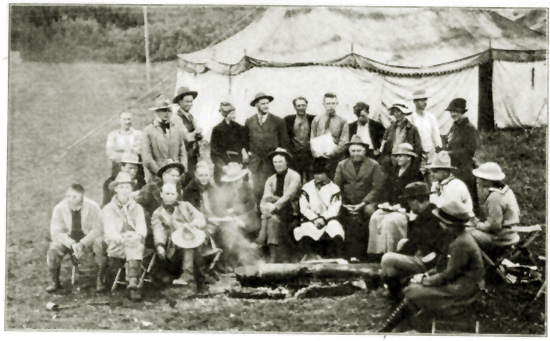
Portion of Eaton Party, Glacier National Park, 1915. Howard Eaton fifth from
left in top row.
Across Montana toward her meeting with the Eaton Party at Glacier, Rinehart travelled:
West. Still west. An occasional cowboy siloutted against the sky; thin range cattle; impassive Indians watching the train go by; a sawmill, and not a tree in sight over a vast horizon!
Red raspberries as large as strawberries served in the dinner, and trout from the mountains that seemed no nearer by mid-day than at dawn!
In due course, Rinehart arrived
in West Glacier. On the platform to greet her were Howard Eaton and 93 year-old chief Three Bears from the
Blackfeet Tribe. Others had arrived from the Eaton Brothers' Ranch. The party of 42 in addition to Eaton's staff, in Rinehart's words were an "entirely different, blase, feeble-muscled,
uncertain, and effete Easterners." The party addlitonally included consisted of two wagons and 33 horses. Rinehart
was assigned a horse named "Gold Dollar." Among those in the party were cowboy artist Charley Russell, a motion picture cameraman and a still
photographer. Russell accompanied Eaton on many of his excursions always without charge.
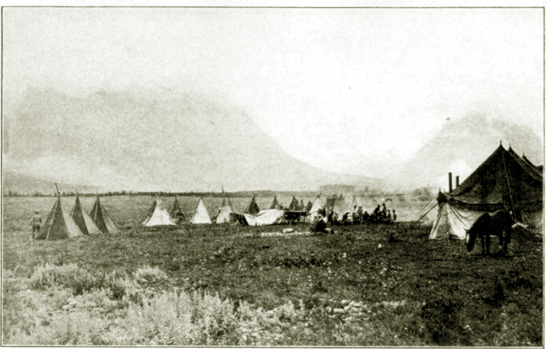
Eaton Camp, Swiftcurrent Lake, Glacier National Park, 1915. In the distance is Altyn Mountain and
Many Glacier Hotel.
The book, Through Glacier Park, Seeing America First with Howard Eaton, Houghton Mifflin Company, appeared in 1916. In it she described
Howard Eaton:
Howard Eaton is extremely young. He was born quite a number of years ago, but what is that? He is a boy, and he takes an annual frolic. And, because it means a cracking good time, he
takes people with him and puts horses under them and the fear of God in their hearts, and bacon and many othere things, including beans, in their stomachs.
He has taken foreign princes and many of the great people of the earth to the tops of high mountains, and shown them grizzly bears, and their own insignificance, at one
and the same time. He is a hunter, a sportsman, and a splendid gentleman. And, because equipment is always a matter of much
solicitude on the part of the novice, I shall tell you what he wears when, on his big horse, he leads his long line of riders over the trails. He wears a
pair of serviceable trousers, a blue shirt, and a vest!. Worn by Howard Eaton, believe me, they are real clothes. He has hunted along the
Rockies from Alaska to Mexico. He probably knows Montana, Wyoming, and Idaho as well as any man in the country. Rinehart, pp 9-10.
At the end of the book, Rinehart summed up Howard Eaton. He was, she wrote, "[A] calm-faced man with twinkling blue eyes, who is proud of his 'boys' and his friends all over the world * * * ."
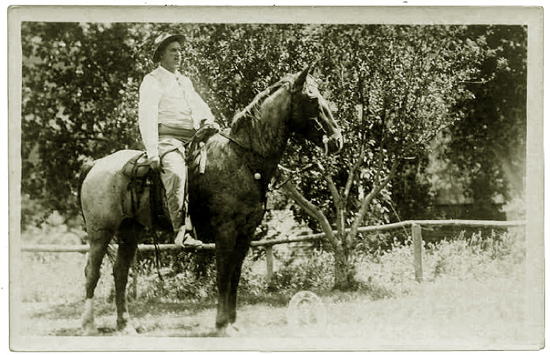
Howard Eaton, 1917.
In the evenings about the campfire, Russell and Eaton would tell stories. Eaton was good as a story teller. Arthur Aloysius "Pete" Dailey (1893-1973), later famous for his
photographs of the Eaton Ranch, recalled:
Every night on these camping trips after the camp was pitched, dudes and "hands" alike gather around the blazing log fire in the
center of the camp, dead tired and sore from the day's ride and the day's work. But Howard Eaton in about as spry and chipper as a bell-boy in a summer resort hotel -- even though he has been doing as much work,
if not more, than any one of the "hands."
* * * *
And then Uncle Howard gets started telling stories of the early days -- and when it comes to telling stories is is hard to find his dqual. Heis
experiences would fill a book. He can keep a crowd entertained for a year with stories of Indian fights, buffalo running, big game hunting, and
tales of interesting characters he has met and acted as guide for
without ever a repetition or a dull moment.Dailey, Arthur A.: "Uncle Howard Eaton, A seventy-Year Old Cowpuncher who Teaches
Easterners How To Be Wild", Outing Magazine, July-August, 1920, p. 200
Pete recieved the nickname "Pete" when he first arrived at the Eaton Brothers in 1912 to join some class mates from
the University of Illinois as a "hand." When he first met Howard Eaton, he jokingly told Eaton that his name was
Pete Dailey, the name of a cheap cigar, a box of 50 of which sold for $1.50. The name stuck. Before the United States
entered in World war I, Dailey with others from the University of Illinois joined French forces as an ambulance driver.
After the war, he returned to the Univeristy of Illiois where he majored in journalism and served as the
staff cartoonist for the 1919 Yearbook, writing and illustrating, among other things, a history of the Illinois Ambulance Unit in France.
Following his graduation in 1920,
he worked as an advertising copywriter for Eastman Kodak. Periodically, Dailey returned to the Eaton Brothers' Ranch to take photographs. Some of his
photographs appeared in brochures for the ranch. Brochures had been regularly published by the
Ranch since the move to Wyoming in 1904.
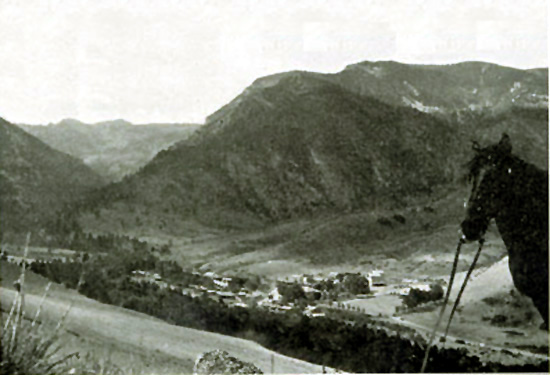
View of Eaton Brothers Ranch, 1933, Photo by Arthur A. Dailey.
In the 1930's, Dailey was the
script writer for WBBM's "lucky Star Ranch" children's radio program. The "Lucky Star Ranch" was based on the
Eaton Brothers' Ranch. Later Dailey
became an advertising director for the Sante Fe Railroad. Following retirement from the railroad, he devoted full-time to photography.
In 1963 he was made
an Associate of the Royal Photographic Society. A permanent exhibit of his photographs may be seen
at the Sagebrush Community Art Center, Sheridan.
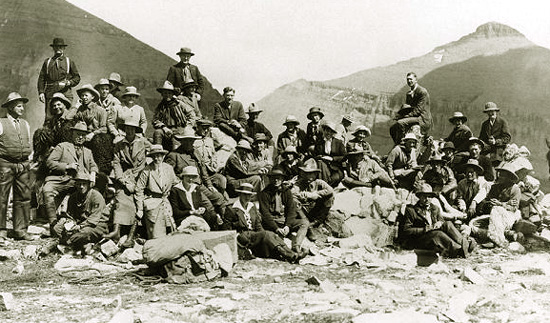
View of Eaton Party, Glacier Nationa Park, 1915; Howard Eaton standing, with vest, at
far left. Charley Russell seated at right. Mrs. Rinehart believed to be lady seated behind gear.
But if Howard Eaton was a good story teller, Charley Russell was better. Russell would later have a cabin
on Lake McDonald in the western part of the park. Raphael James Cristy later wrote that Visitors would have to perform their morning
absolutions in the lake. "The icy waters in Lake McDonald, recently melted from
mountain snows and glaciers, took the breath way and made most swimmers' teeth chatter, no doubt contributing to
Russell's non-stop yarn-spinning during personal scrubbing and washing."
Raphael James Cristy: Charles M. Russell, The Storyteller's Art,
University of New Mexico Press, p. 28,
Writer's personal comment: indeed, the waters of Lake McDonald are somewhat cool. The writer once went swimming in the lake.
The water was such that as he waded into the lake, he tried to incrementally make himself taller, until finally the plunge had to be taken.
The swim was short in duration. It was not,
however, the coldest the writer has ever been. That was once when the writer was caught four hours out from the stables in a unexpected summer
hail storm in the Rockies. Even though the writer had a poncho, the meling hail somehow
found its way down the back of his neck. Portions of his levis turned tan from the dye on the saddle.
It took two hours for his teeth to stop chattering.
And it was through the trips to Glacier, that Russell's protege Joe De Yong came into contract with the Eaton Brothers
Ranch. De Yong later provided art work and consulation for a number of major Hollywood movies. From 1923 to 1929 De Yong as "Kid Currycomb" edited
the Eaton Brothers' newsletter Wranglin' Notes.
The following year, in 1916, Rinehart again journied back to Glacier and accompanied Eaton on his two-week tour of the
eastern part of the park. She then took a separate tour of the previously unexplored western part. Again, the tour became part of a book, "Tenting To-Night," in which
Eaton also received mention. In 1920, Rinehart accompanied an Eaton tour of parts of the southwest, described in her
1923 The Out Trail. Although, Mrs. Rinehart made it seem like she was roughing it, the
Eaton Party travelled in seven motor cars and three trucks. For a number of years Rinehart made her summer home at Eaton Brother's ranch.
She later wrote two novels featuring Wyoming,
"Breaking Point," 1927; and Lost Ecstacy, 1927. Through the Eaton Brothers' Ranch she met the Bones Brothers who were then working there.
They took her to a roundup near Birney. A description appeared in a later work.
On April 5, 1922, after having first appeared to be recovering from appendicitis, Howard Eaton died. Over the next several years, in various magazines across the
country devoted to the outdoor life, remembrances of Howard Eaton were published. Edward Gillette wrote to
Forest & Stream. Field and Stream, June, 1922, had an extensive obituary:
HOWARD EATON
HOWARD EATON died April 5th in Sheridan, Wyoming. His death takes from us an old-time dweller
of the once Far West, a real pioneer and, above all, one whose character had endeared him to a
very wide circle of friends.
He was an old-time neighbor and friend of Theodore Roosevelt; and it is said that it was an
enthusiastic letter written by him that induced Mr. Roosevelt to go out to the Little Missouri
and to start in the cattle business.
With his two brothers—each of the three the soul of hospitality—Mr. Eaton long kept open
house at his ranch near Medora, on the Little Missouri River; and later, when he moved south
to the flanks of the Big Horns in Wyoming, the brothers established a resort for eastern and
western people, which became a favorite stopping place for summer people from all over the
country. Of those who came there and met him, all grew to know and love Howard Eaton.
Howard Eaton had wrestled with the wilderness for many years, and in this struggle had absorbed
many of the fine qualities which are likely to come to the man who lives much in the open.
Through a long career on the plains and in the mountains, his personality had become known to
thousands, and by all these he was beloved. He had a singular charm of manner and was a
delightful entertainer, bubbling over with anecdote and wit which made him the best of company.
Beyond all this and more potent than this in binding people to him was the quality of intense
sympathy that he gave out to those he met.>dd>
During his many years' experience in the West, Mr. Eaton had been a hunter and had killed
much game, from buffalo to birds. He was a keen sportsman; but he loved the wild creatures
that he had known so long and so well, and in his later years he became more conservationist
than hunter. He was active in efforts for the protection and increase of wild life—an advocate
of good protective laws and a worker for restocking barren game areas. He procured for the
Yellowstone Park the buffalo from which has sprung the tame buffalo herd there; and Col.
John Pitcher used to speak of him as the father of that herd.
His death followed an operation for appendicitis, and was unexpected, for he had been doing
well for a week, up to within a few hours of his death. When that event came, he was
seventy-one years old.>dd>
Howard Eaton's passing on carries grief to many hearts, and many will echo the words spoken
by an old friend when he first heard the rumor of his illness— "We can't spare Howard."
Even years later, Dan Beard, a founder of the Boy Scouts of America, later summed up Howard Eaton. He, Beard wrote,
"had a heart as big as an ox." Beard recalled that
"Howard's heart was so big that he could not call a man down, even when he
knew the man to be wrong; he was so kind-hearted, in truth that rather than prove that a man was wrong, he would help the fellow to think that he was right."
Boy's Life, Sepember 1928, "Some Real Pioneer Stunts that Work."
In 1923, Yellowstone Park Superintendent Horace Albright; National Park System Director Stephen Mather, the two
Eaton boys and official photographer Jack Haynes gathered near Sheep Eater Cliff where Eaton usually started his tours and
dedicated the Howard Eaton Trail. The trail, some 151 miles long through the center of the Park,is now for the most
part, abandoned, unused, and in a state of neglect. Approximately five 1/2 miles are now in regular use.
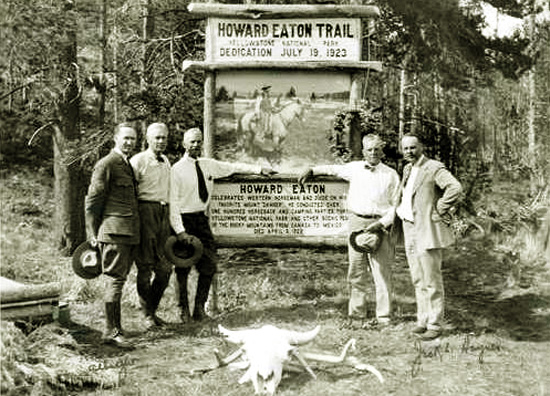
Left to Right: Horace Albright, Stephen Mather, the two Eaton boys, Jack Haynes. In the image of
Eaton on the sign, Eaton is riding his favorite horse "Danger." The sign is now gone.
The two boys planted a memorial tree. Chief Ranger Woodring led the party to Sheep Eater Cliff, a horse with an
empty saddle immediately following Woodring.
Next page: Eaton Brothers' Ranch continued.
|